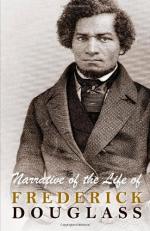|
|
The Narrative of the Life of Frederick Douglass Author/Context
Frederick Douglass was born in Talbot County, Maryland. The date of his birth is estimated to be around the year 1818. His mother was a slave named Harriet Bailey. His father was generally acknowledged to be a white man, quite possibly his master, Captain Anthony. As a young boy, Douglass lived the typical life of a slave on a Southern plantation. He suffered through constant hunger and cold. He was also exposed to the extreme barbarity of slavery.
In 1826, at the age of seven or eight, Douglass was sent to live in Baltimore with Captain Thomas Auld's brother, Hugh Auld and his wife, Sophia. Douglass was overjoyed at the prospect of moving to the city. The move to Baltimore was considered to be the first major turning point in Douglass's life. There, Douglass learned how to read and write. At the age of twelve, Douglass was able to get a copy of Caleb Bingham's book, The Columbian Orator. In it, Douglass found the short piece entitled "Dialogue Between a Master and Slave" by John Aikin to be the most instrumental in fueling his desire for freedom. Another noteworthy experience in Baltimore-not mentioned in the narrative-is his religious awakening. During the dispirited times of his adolescent age, he found great support from quite a number of religious people.
Because of a dispute between the two brothers, in 1833, at the age of fifteen, Douglass was sent back to Talbot County to live with his old master, Captain Thomas Auld. Douglass and Captain Thomas did not get along, mainly because Douglass had no respect for him as a slaveholder. Wanting to break him, Captain Thomas sent Douglass to work for a reputed "nigger-breaker," Mr. Edward Covey. After six months of constant work and beatings, Douglass decided that he would fight back or die. After engaging Mr. Covey in a fight for two hours, Douglass was never harmed again. This event is described as another major turning point for Douglass-the day he became a man. After a year working for Mr. Covey, Douglass worked for Mr. Freeland, whom Douglass described as the best master he ever had. In 1836, Douglass and some other slaves attempted an unsuccessful escape. Douglass was put in jail, but somehow, Captain Auld sent him once again to live with his brother in Baltimore. Back in Baltimore, Douglass learned how to calk (caulk) and was soon making money for Mr. Hugh Auld. He was involved with a group of free Negroes who called themselves the East Baltimore Improvement Society, where he first developed his oratory skills. He also met his future wife, Anna Murray, at a social gathering of a Methodist congregation. She was a free Black woman who provided Douglass with further motivation to escape. Finally, on Monday, September 3, 1838, Douglass escaped to his freedom, reaching New York by train.
Upon settling in New Bedford, Massachusetts, Douglass started his career as an abolitionist after speaking at a state Anti-Slavery Society meeting in Nantucket. Douglass wrote the story of his narrative and it was published in May 1845, instantly becoming a best seller. He wrote two more memoirs, My Bondage and My Freedom (1855) and Life and Times of Frederick Douglass (1881). He became a sought-after speaker for the abolitionist movement in the states and abroad. He also took on various journalistic responsibilities for the anti-slavery cause. Frederick Douglass served in many government positions, using his power to defend human rights, including slaves and woman. He died in Washington D.C. on February 20, 1895, at around the age of 77.
Frederick Douglass's narrative is considered to be the greatest among the rich genre of slave narratives. Houston Baker Jr. writes, "Douglass's work is an American classic that has only recently received the sophisticated scholarly exegesis (criticism) it so richly deserves."
Bibliography
Chesebrough, David. Frederick Douglass: Oratory from Slavery. Westport: Greenwood Press, 1998.
Douglass, Frederick. Narrative of the Life of Frederick Douglass, an American Slave. New York: Penguin Books, 1982.
Lampe, Gregory. Frederick Douglass-freedom's voice. East Lansing: Michigan State University Press, 1998.




